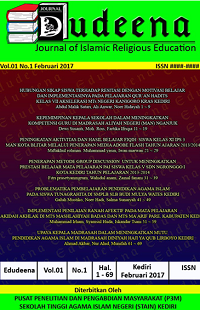Strategi Pembelajaran Kooperatif Tipe Jigsaw Versus Pembelajaran Langsung
DOI:
https://doi.org/10.30762/ed.v2i2.724Keywords:
Pembelajaran kooperatif, Jigsaw, pembelajaran langsung, direct instruction, Cooperative learningAbstract
Abstract: Learning method or technique and learning strategy need to be notice in learning activities. This study aim to discusses cooperative strategy. Cooperative strategy has some elements; (1) Positif depending to each other (2)face to face meeting (3) individual responsibility (4) group and interpersonal skill (5) effective group process. Some of the cooperative learning basic theories are Behaviourism theory and constructivism theory that have differ point of view. Benefit of cooperative learning could be divided into four aspects (1) improving positive attitudes toward learning activities (2) Increasing student interaction to each other (3) improving student learning achievement ,(4) authentic assessment. Then, Jigsaw in cooperative learning is a product of social constructivism. Slavid stated technique that use appropriate approach based on social cohesive are Jigsaw, Group Investigation and learning Together (LT).
Abstrak: Salah satu masalah yang memerlukan perhatian dalam kegiatan pembelajaran adalah metode teknik, dan strategi pembelajaran (learning metbod &technique). Strategi pembelajaran kooperatif memiliki beberapa elemen antara lain; (1) Saling ketergantungan positif, (2) Tatap muka, (3) Tanggung jawab individu, (4) Keterampilan kelompok dan interpersonal, dan (5) Keefektifan proses kelompok. Teori yang mendasari pembelajaran kooperatif dengan mengikuti perspektif yang berbeda. Di antaranya adalah teori behavioristik dan teori konstruktivisme. Manfaat pembelajaran kooperatif dilihat dari empat aspek tersebut; (1)Meningkatkan sikap positif terhadap kegiatan pembelajaran, (2)Menggiatkan interaksi antarsiswa, (3)Meningkatkan prestasi belajar, dan (4)Penilaian otentik. Berikutnya Pembelajaran kooperatif tipe jigsaw adalah produk dari perspektif konstruktivisme sosial. Sebagaimana Slavin menyebutkan teknik yang menggunakan pendekatan yang sesuai dengan pandangan kohesif sosial adalah Jigsaw, Group Investigation, dan Learning Together (LT).
Downloads
References
Adam, G.L., dan Engelman, S. 1996. Research on Direct Instruction: 25 Years Beyond Distar. Seattle: Educational Achievement System. (206): 820- 6111
Arends, R.I. 2007. Learning to Teach. New York: McGraw Hill Companies,Inc., 1221 Avenue of the America.
Astin, A.W., Sax.L.J., Korn,W.S., dan Mahoney, K.M. 1996. The American Freshman: National norms for Fall. Los Angeles: Higler Education Research Institute: UCLA
Deutsch, M. 1985. Distributive Justice, A Social Psichologycal Perspektive. Boston: Ally dan Bacon
Eggen, P.D., dan Kauchak.P.P. 1998. Strategies for Teacher; Teacher Content and Thinking Skills. Boston: Ally dan Bacon
Gokhale, A.A. 1995. Collaborative Learning Enhance Critical Thinking. Journal Technology Education. Illionis University
Jacobsen, D.A., Eggen, P., Kauchak, D. 2009. Methodes for Teaching. New Jersey: Pearson Education, Inc, Publishing as Allyn dan Bacon
Johnson, D.W., dan Johnson, R.T. 1984. Cooperation and Competition Theory and Research. Edina, MN: Interaction Book Co
Johnson, D.W., dan Johnson, R.T. 1991. Learning Together and Alone : Cooperation, Competition, and Individualization (3th Edition). Prentice Hll, Inc. Engglewood Cliffs: New Jersey.
Johnson, D.W., Johnson,R.T., dan Holube, E. 1993. Cooperation in The Classroom, Edina, Minn: Interaction Book Company
Johnson, D.W., dan Johnson, Roger, T. 2004. The New Circle of Learning. Alexandria. Virginia
Joice, B., dan Weil, M. 1986. Models of Teaching. Boston: Allyn and Bacon
Kardi, S., dan Nur. 2000. Guruan Langsung. Surabaya: Unesa. Surabaya
Lie, A. 2002. Cooperative Learning Mempraktikan Cooperative Learning di Ruang-Ruang Kelas. Jakarta: Grasindo
Newman, R.S.1990. Childrens Help Seeking in the Classroom: The Role of Motivational Factor and attitude. Journal of Educational Psycology, 82. 71-80
Newman, dan Artzt, A. 1990. How to Use Cooperative Learning in the Mathematics Class, Ronton,VA: National Council of Teacher of mathemathics.
Panitz, T. 1996. A Definition of Collaborative vs. Coopertive Learning.(http:// lgu.ac.uk./ delibration/coolab.learning/panitz.html, diakses tanggal 15 Juni 2010)
Panitz, T. 2000. Comparing Traditional Tecnick and Collaborative Learning. (http://edweb.gsn.org/edref.sys.learn.html, diakses tanggal 15 Juni 2010)
Piaget, J. 1987. Psychology of Intelligence. Paterson, NJ: Littlefied Adams
Santrock, J.W. 2004. Educational Psychology. McGraw-Hill Company, Inc.
Setyosari, P. 2003. Pengaruh Strategi Pengajaran Konsep melalui Contoh dan Non Contoh, Contoh dan Buku Teks terhadap Hasil Belajar IPS Siswa Kelas V SD. Disertasi. Malang: UNM Malang
Setyosari, P. 2009. Pembelajaran Kolaborasi: Landasan Untuk Mengembangkan Keterampilan Sosial. Rasa Saling Menghargai dan Tanggung Jawab. Pidato Pengukuhan Guru besar. Malang: Universitas Negeri Malang
Sharan, S. 1999. Handbook of Cooperative Learning Methodes. London: Praeger Wesport, Connecticut
Slavin, R.E. 1983. When does Cooperative Learning Increase Student Achievement? Psychological Bulletin, 94 (3)
Slavin, R.E. 1995. Cooperative Learning Theory. Second Edition. Massachusetts: Allyn and Bacon
Slavin, R.E. 1996. Research on Cooperative Learning and Achievement; What are Know, What We Need to Know. Contempory Educational Psychology, 21
Slavin, R.E. 2005. Cooperative Learning, Theory, Research, and Practice. London: Allyn Bacon.
Tudge, J. 1990. Vygotsky, the Zone of Proximal Development, and Peer Collaboration. Implication for the Classroom Practice. Dalam L.C. Moll, (Ed), Vygotsky and education: Instructional implication and application of sociohistorical psychology.New York: Cambridge university press
Woolffolk, A.E. 1995. Educational Psychology. Boston: Allyn and Baco
Downloads
Published
How to Cite
Issue
Section
License

This work is licensed under a Creative Commons Attribution-ShareAlike 4.0 International License.






